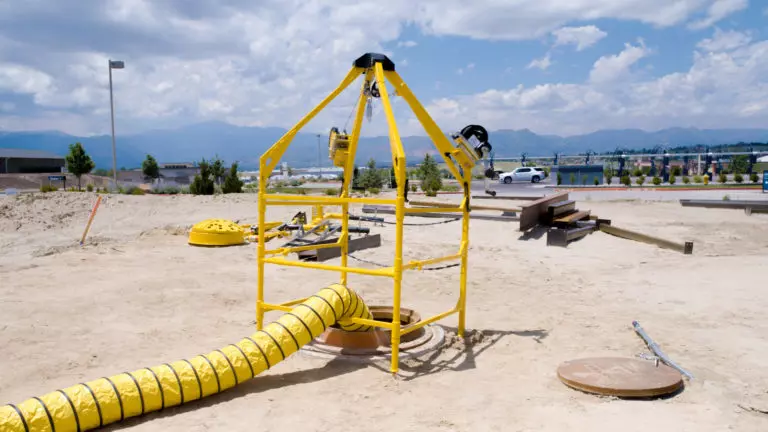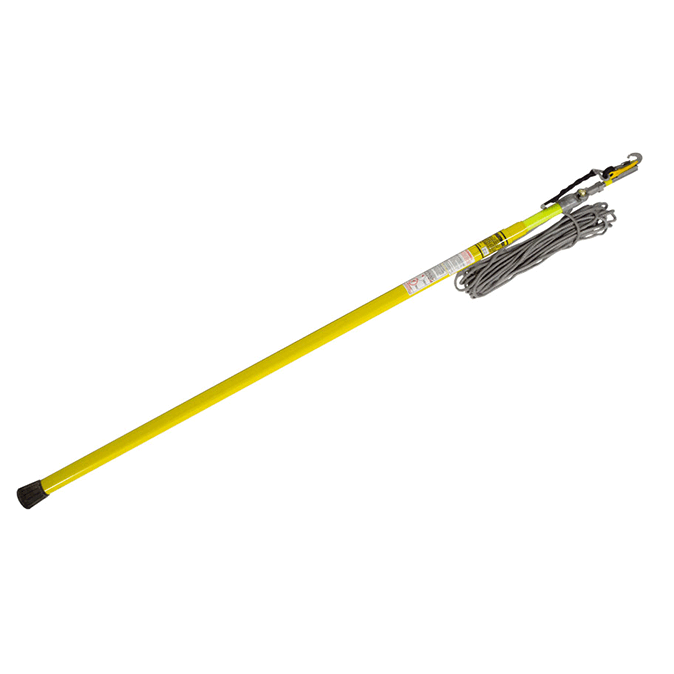Rescue Equipment for Confined Spaces | Shop Now
February 21, 2023
We know that working in confined spaces can be dangerous, making it essential for you and your team to have the right rescue equipment on hand in case of an emergency. Our decades of experience designing fall protection tools has led us to thoroughly appreciate and understand the vital role rescue equipment plays. Rescue equipment does not just protect lives, but it can save them, too.
Each year in the United States, an average of 100 deaths occur in workplaces due to confined spaces, with the majority caused by workers entering oxygen-deficient or toxic atmospheres. Over 60% of these documented deaths are among individuals attempting to rescue the affected workers.
In a previous post, we talked about self-rescue, non-entry rescue, and entry rescue in order to help you to understand the types of confined space rescue and which to use. Here, we’ll focus on three crucial rescue tools that are appropriate for a variety of confined space work and rescue settings.
Essential Rescue Equipment for Confined Spaces
You need durable fall protection that you can rely on at any given time. Some of our most innovative tools designed with your safety mind, include:

The Pelsue LifeGuard is the ultimate solution for fall protection in confined spaces. It offers you critical anchorage for hoists and self-retracting lifelines (SRLs) to ensure safety and facilitate rescue, while also serving as a barrier to prevent accidental entry into a confined space.
The Lifeguard confined space system can be employed in cases where an individual is either unconscious or unable to move, in order to extract them from the confined space in a safe manner.
Watch our video to see how the Lifeguard System can make your non-entry rescues efficient and safe.

The Pelsue Rescue Pole is intended for efficient, non-entry rescues in confined spaces. It can be operated by a single person with the capability of reaching distances of up to 16 feet 9 inches. It is compatible with Pelsue Quick Rescue Hoists. Built from durable fiberglass, the Rescue Pole has a voltage rating of 100,000 volts per foot per 5 minutes.
In situations where a person is unconscious or unable to move, the Pelsue Rescue Pole can be used to safely remove them from the confined space by using the hook to lift them out.
Watch our video to see how the Rescue Pole can make your non-entry rescues efficient and safe.

Designed specifically for quick and efficient rescue operations, the key feature of the Pelsue Quick Rescue Hoist is that the line is not permanently attached to the hoist drum. When used with the Pelsue Rescue Pole, it allows your rescue team to connect the line to a person in need of rescue, even from outside a confined space. It can then be used to lift the person out of the confined space. This makes it the perfect solution for emergency rescue in situations where the person is not already hooked up to a hoist or SRL.
In situations where a person is unconscious or unable to move, the Pelsue Quick Rescue Hoist can be used to safely remove them from the confined space by lowering or raising them out.
Watch our video to see how the Quick Rescue Hoist can make your non-entry rescues efficient and safe.
What is a Confined Space?
A confined space is an area that is enclosed, not intended for human occupancy, and has limited or restricted means for entry and exit. Confined spaces can include tanks, vessels, silos, storage bins, hoppers, vaults, pits, manholes, tunnels, equipment housings, ductwork, pipelines, and more. These spaces can pose a risk of serious injury or death to workers and emergency responders due to hazardous conditions, such as lack of oxygen, toxic gases, or engulfment.
In a previous post, we talked about the two main OSHA standards – OSHA 1910 – General Industry and OSHA 1926 – Construction Alteration and/or Repair that cover fall protection systems as well as the basics of fall protection and rescue for confined spaces.
Confined Space Settings Where Rescue Equipment is Essential
The Lifeguard, Rescue Pole, and Quick Rescue Hoists come in handy in a variety of situations:
Rescue operations in industrial settings such as in tanks, silos, and vaults that contain hazardous materials or gases. Confined spaces can often be cramped, dark, and have limited access, making it difficult for rescuers to safely move around. These spaces pose an increased risk of falls due to the presence of dangerous materials or gases. This can make the air unstable or toxic. To minimize the risk of accidents or injuries, we recommend that fall protection equipment should always be used while following all safety protocols and guidelines.
Emergency response situations where someone has fallen into a confined space, such as a manhole or drainage ditch. Confined spaces can be difficult to access and may have limited visibility. This makes it challenging for rescuers to safely reach and retrieve a person who has fallen. This person may have suffered injuries, making it difficult for them to climb out on their own. To ensure the safety of both the rescuers and the victim, fall protection equipment such as the Lifeguard, Rescue Pole, and Quick Rescue Hoists should be considered. This equipment can help prevent falls and injuries while rescuers are working in confined spaces.
Confined spaces that are difficult to access like underground tunnels, mines, or caves. Underground tunnels, mines, and caves pose unique hazards and challenges. One key consideration is the potential for limited access and egress, making it difficult for workers to exit the space quickly and safely in the event of an emergency. Another factor is the potential for hazardous atmospheric conditions (i.e., low oxygen levels or the presence of toxic gases). Proper ventilation and the use of monitoring equipment is needed to ensure the air quality is safe.
Confined spaces can make installing traditional fall protection systems like guardrails or safety netting difficult. Workers may need to rely on personal fall arrest systems such as harnesses and lanyards.
In situations where a person is trapped or in distress, and a rescue needs to be performed quickly and safely. Your fall protection considerations should be balanced against the need for a rapid response. Rescuers may need to enter the space from an elevated position (i.e., through a manhole or shaft). It is important to have a backup system in place in case your primary fall protection system fails. A clear and well-defined rescue plan in place is just as important to have. A rescue plan will have designated rescue personnel and equipment that is easily accessible and ready to be used. Proper training, communication, monitoring of air quality and the use of appropriate equipment are essential.
Training on Rescue Equipment Ensures Safety and Effectiveness of Rescue Operations
In addition to the equipment, proper training is essential for workers and responders who may need to perform confined space rescue. This will help ensure your fall protection equipment is used correctly and that rescue efforts are effective.
Training should cover all aspects of your equipment, including how to properly set up and use it, as well as any safety precautions. It should also cover the specific procedures for confined space rescue, including how to identify and assess the risks, how to properly enter and exit a confined space, and how to safely perform a rescue.
It is also important to ensure that your training is up-to-date. Employees should be given regular refresher trainings. In case of an emergency, it's important to have a rescue plan in place, and to make sure all workers and responders are familiar with the plan.
Conclusion
Having the right rescue equipment for confined spaces is essential for the safety of everyone involved. By investing in the proper equipment and training, companies and emergency responders can ensure that they are prepared to handle any emergency that may arise in a confined space.
Rescue equipment like the Pelsue Lifeguard system can be extremely useful in situations where a person's life is in danger and access to the confined space is limited or difficult. It provides a safe and efficient way for rescuers to enter, perform the rescue, and bring someone to safety. The Rescue Pole can be used to reach and retrieve a person in tight spaces or areas that are difficult to access. It can also be used to help guide or direct someone out of a confined space, providing an extra level of safety for both the rescuer and the person being rescued.
Finally, the Quick Rescue Hoist allows a rescuer to enter and exit the confined space safely and quickly. Designed to be easy to set up and operate in emergency situations, it provides a safer and efficient way for rescuers to reach and retrieve someone from a confined space.
Related Products:
Permanent Base Davit Fall Protection System, Personnel Hoists, Uni-Lite Fall Arrest Post, Self-retracting Lifelines
Additional Resources:
OSHA Personal Fall Protection Systems – Laws and Regulations
EHS Today Fall Protection and Confined Spaces
Pelsue Fall Protection Rescue Systems for Confined Spaces
FAQs
When do employers need to put fall protection measures in place?
Employers should put fall protection measures in place whenever their employees are at risk of falling. This means that if a worker is working at a height of 4 feet or higher above the ground, fall protection is a must.
How often should fall protection equipment be inspected and maintained?
Fall protection equipment should be inspected before each use and maintained in accordance with the manufacturer's instructions. This may include regular cleaning, lubrication, and replacement of worn or damaged components.
Why do I need a harness for confined space rescue?
Harnesses are used for confined space rescues to provide a secure attachment point for the rescuer, ensuring they can safely enter and exit the confined space and perform the rescue without the risk of falling or becoming injured. Many harnesses come equipped with D-rings that can be used to attach other equipment, such as a lifeline or a SRL which allows the rescuer to move around the confined space safely and easily.
What are some general safety requirements for confined space entry?
General safety requirements for confined space entry include proper ventilation, adequate lighting, proper PPE, and a means of communication with the outside. It is also important to have a trained attendant outside the space who can monitor the workers and provide assistance if needed.
What is the lifespan of a fall arrest post?
The longevity of fall arrest posts and similar equipment can vary depending on use and maintenance. When properly inspected and maintained, fall arrest posts can have a long lifespan, and only need to be replaced when inspections reveal signs of wear or damage. However, if a fall arrest post is utilized frequently, there is a higher likelihood that it will sustain damage.

